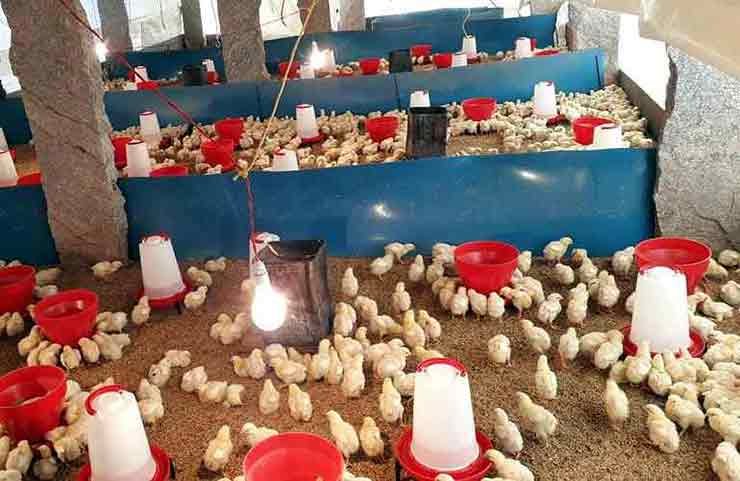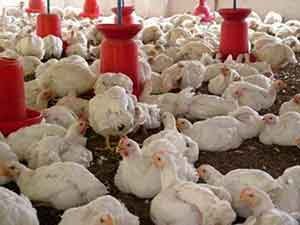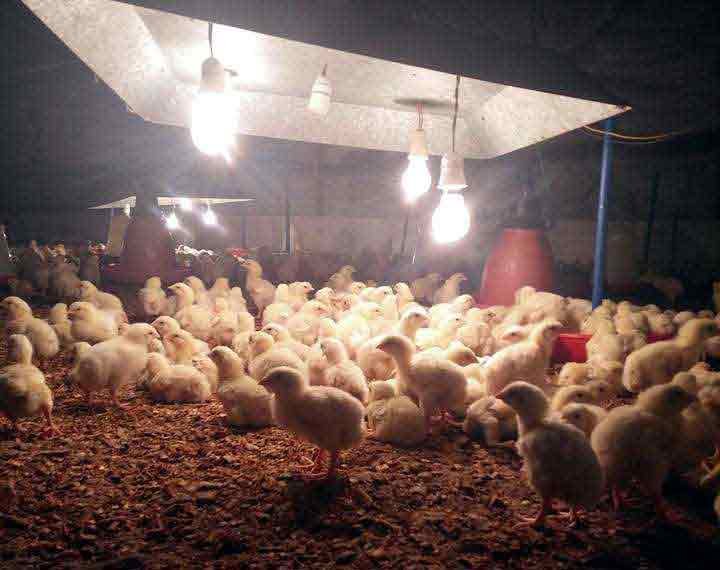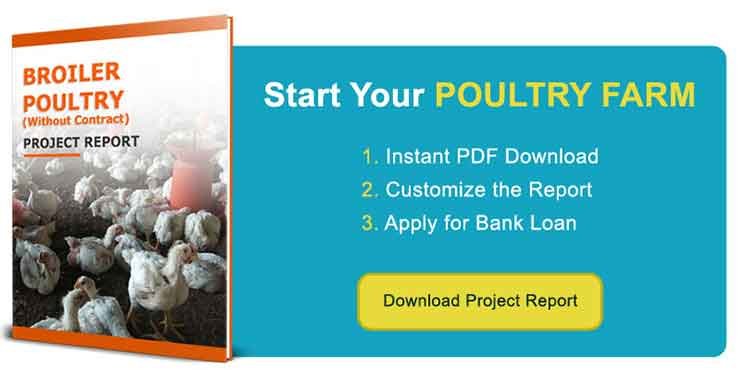Broiler chicken farming is one of the most profitable livestock business in India. Broiler farming can be done in small scale poultry farm to large industrial broiler farm. Discover how to plan and set up a broiler farm in India.
Broiler chicken is the most popular bird in poultry farming in India. Broilers are reared for commercial marketing of the chicken meat. Broilers are small chickens that are 5-6 weeks old. They are tender with flexible bones. Broiler farming need very little investment since they can be grown and marketed within six weeks.
The tender meat of a young chicken grown from a hatch is called broiler. In its broadest sense, broilers are chicken raised specifically for the meat purpose from its hatch. It is an important protein source. It also contains vitamins and minerals in sufficient amounts. Owing to the technological advancements and commercial development there are specially developed broilers available. These breeds are different from egg layering birds used in layer poultry farming. These grow quickly and have a high efficiency of conversion. In addition, poultry manure has a very high fertilizer value that can be used for increasing the crop yield in organic farming.
Information on Broiler Poultry
Gallus gallus domesticus or broilers typically have a yellowish skin and white feathers. They attain their slaughter weight between 4-6 weeks of age. However, slow growing ones attain slaughter weight when they are 14 weeks old. Since the broilers are slaughtered young, they are immature.
Scope of Broiler farming in India

India is the fifth largest broiler producer in the world. However, the per capita availability of poultry meat is far below the ICMR recommendation which is 11 Kg meat per capita per annum. Farmers no longer find it difficult to market the broilers since there are many corporate companies that have enabled a suitable rearing environment for the farmers. Since broiler chickens are slaughtered at the age of 6-8 weeks farmers find it easier to rear broilers. Broilers provide adequate employment opportunities to the poultry production system. In past few years, considerable progress has been made with respect to equipment, vaccines, technical guidance, etc. Owing to an improvement in the management practices, occurrence of mortality has decreased to a great extent. There are also institutes providing training to entrepreneurs. Also since there is considerable importance given to broilers in the national policy, the scope for further development seems good.
Broiler Chicken Breeds
Since broiler breeds are reared chiefly for meat purposes they are divided into 2 categories:
- Commercial broiler breeds
- Dual purpose broiler breeds
Commercial Broiler Chicken Breeds
They are reared for the chicken meat alone and are slaughtered when they attain 6-8 weeks of age. There are genetically modified commercial broiler breeds available. These are modified genetically to produce meat rather than egg. Such breeds have increased meat production and a higher conversion rate. The chicken can be of either sex. Some examples of broiler chicken that are bred commercially are Hubbard, Cobb, Caribro, Avian, Krishibro, Varna, Vencobb, Hy-cobb, etc.
Dual Purpose Broiler Chicken Breeds
Dual purpose breeds are reared for both eggs and meat. They are generally the ‘backyard’ variety. They are self-reliant, hardy and have a larger body. The eggs that they lay have a brown-colored shell. Some examples of this breed are Rhode Island Red, New Hampshire, White Plymouth Rock, Gramapriya, Red Vanaraja, etc. To learn more about ‘backyard’ varieties read our country chicken farming guide.
House Facilities and Management

The housing facilities for poultry must be situated away from industrial area, yet have a good accessibility such as good roads, markets, etc. Basic facilities like clean drinking water must be available. The hen coop or the houses must be constructed at a elevation so that there is no water logging during heavy rains. There should adequate amount ventilation, sunlight and shade. The fresh air must pass through the brooder shed, grower shed and layer shed precisely in that order. This would prevent the spread of diseases from layers to brooder. Store rooms, administration office, etc. must be located at the entrance of the housing facility to minimize the movement people around the sheds. Similarly sick room and disposal pits must be located at the extreme end.
Broilers can be reared in cages or on floor litter. The cage construction is similar to grower cage with the floor having a plastic coating to avoid blisters.
The Advantages of Cage Rearing in Broiler Farming
- High rearing density
- Litter expense is negligible
- It is easier to disinfect and clean the area.
- The growth and feed efficiency of the birds is better.
- Reduced incidence of cannibalism.
However, cage rearing the broilers have some disadvantages too.
Disadvantages of Cage Rearing in Broiler Farming
- Initial cage investment is high.
- Fecal tray cleaning is a laborious process.
- The wing bones tend to be brittle.
- There is a higher chance of the broilers developing breast blisters and crooked keel.
- During summers the birds are restless owing to heat and lack of fresh air circulation.
Up to the age of 18 days, broilers need 450 cm2 of floor space, 3cm feed space and 1.5 cm water space. For birds ranging from 19 to 42 days of age they need a floor space of 1000 cm2, 6-7 cm of feed space and 3 cm of water space.
Poultry House Design
The houses must be constructed in the north-south direction. Constructing them in the East-West direction would expose them to the sunlight. It is advisable to use locally available materials like mud, bamboo, etc for constructing the house than investing in procuring materials for building the coop. The investment can be made in procuring breeds, feed etc.
Broiler Farming Management

Since broilers are reared for meat a systematic, well-planned broiler management is necessary to get the desired results. Rearing is followed in different ways. They might be reared as a single batch or in multiple batches of brooding and rearing.
Single Batch
Also called as ‘all-in-all-out’ system, the farm has only one batch of broilers being reared at a given time. In other words, the chicks would belong to the same hatch. They are purchased as per the farm capacity, reared and marketed in one single lot. It is a more planned system as there is only one batch of birds all belonging to the same hatch to be dealt with at one single time. It also reduces chances of developing infections or the spread of a disease. The mortality rate is reduced while the feed conversion and growth rate is enhanced and more efficient. This system is however only suitable for a small poultry farm. It is not suited for a large farm with higher capitals.
Multiple Batch
As the name suggests, more than one batch of chicks belong to different stages of hatching are reared. The batch interval varies between one to four weeks. The farmers buy day-old chicks and rear them for upto five to six weeks before marketing them. While they buy the chicks, they also sell broilers that maybe 5-6 weeks. They are sold when they attain the desired body weight. Generally they are sold for table purposes. Farmers ideally have 5-6 batches of broilers at any given time. The time interval between two batches maybe 2-4 weeks. They are generally sold in direct retail marketing. Birds of 45-50 days of age who are healthy and have attained the desired body weight are sold. While heavier birds are sold early, the weaker ones are reared for a longer period to let them compensate the body weight.
Broiler Management
Selection and Observation

For breeding and rearing day old, healthy chicks are selected. A healthy chick is generally curious and is always exploring things around the brooder. They scurry away when someone approaches to avoid being captured. Usually, they are very active but huddle together when sick, hungry, tired, cold or scared. A healthy chick has alert, bright and open eyes. In case the chicks stare away and do not react when approached it is an indication that they are sick. The legs of a healthy chick are straight and stand tall. Crooked legs maybe signs of deformities and not necessarily an indication of sickness. However they may also be symptoms of an underlying physiological condition.
Poultry House Preparation
The coop must be cleaned thoroughly and free of any litter. The entire poultry house must be sanitized properly and disinfected. Some farmers fumigate the house before the chicks are brought in. The incubators or brooders are adjusted to the desired temperature a day before the chicks arrive. For the first few days they are observed for any signs and symptoms of infections or diseases. In case a bird develops any infection, it is removed from the brood and quarantined immediately.
Lighting
Broiler houses are recommended to provide 24 hours of light during the brooding time. The pattern followed is 23 hours of light followed by an hour of darkness everyday till they are ready for marketing. The one hour darkness is to acclimatize the birds towards darkness in case there is power failure else there maybe panic and stampede.
Feeding
Food plays a major role in poultry farming since the birds have a high conversion rate. For efficient poultry management on a commercial scale, feed management is an important aspect. The feed must be healthy in terms of nutrition and they must contain adequate amounts of vital nutrients. Insufficient amount of nutrients would lead to poor performance in terms of productivity. Apart from the regular fats, proteins, carbohydrates, vitamins and minerals, they must be also provided with micronutrients in adequate amounts.
Vaccination
Like any other livestock broilers must be vaccinated regularly and protected from diseases. They are vaccinated right from the first day of their hatch till the 28th day.
| Age | Vaccine | Route of Administration |
|---|---|---|
| Day 1 | Marek’s | Sub-Cutaneous at the neck |
| 5th-7th Day | RDV F1 | I/N |
| 14th Day | IBD Vaccine | I/N |
| 21st Day | RDV La Sota | Drinking Water |
| 28th Day | IBD booster dose | Drinking Water |
Sex Separation of Broilers
The growth rates of male and female broilers are not the same with the males growing faster than females. They also need more floor space and nutrients than female broilers. Male broilers need more proteins and carbohydrates in their diet than their female counterparts. Hence, male and female broilers are reared separately from the day of hatching till marketing. They are also provided with separate diets as per their daily requirement.
Biosecurity in Broiler Chicken Farming
Biosecurity is applying logic and principles specific to a broiler farm for evaluation of farm operations and monitoring the status of diseases. It also involves continuous evaluation of farm operations to contain diseases. Some of the steps involved are:
Fencing
Fencing is done to ensure that the birds do not escape from the coop. The fencing must be high enough to prevent the birds from escaping. The opening of the fence must also be locked and guarded properly.
Visitors
Visitors to the broiler farm must be bare minimum. This is to avoid the broilers from panicking. In addition, restricting visitors would help arrested development and spread of diseases.
Pest Control
Pests and rodents must be controlled as they are vectors of diseases. Adequate measures must be taken to control the rodent population.
Manual Checking
The birds must be checked regularly manually for development of disease symptoms. Dead birds if any must be disposed immediately in a humane way.
Marketing in Broiler Chicken Farming
The broilers are marketed when they are five to six weeks old. In India, broiler marketing must be planned in advance. This is especially because in India, meat does not have much market value during festival times.
Reference
- http://agritech.tnau.ac.in/animal_husbandry/ani_chik_breeds%20of%20chicken.html
- http://vikaspedia.in/agriculture/poultry/breeds-of-poultry/housing-for-layers#section-6
- http://dahd.nic.in/sites/default/files/Excerpts%20of%20Poultry%20Farmn%20Manual-ilovepdf-compressed.pdf
- https://drive.google.com/file/d/18mTbfrh1Ugb13_yaxTUGftlUM_a-UHPY/view?usp=sharing

I want to know the medicines or vaccines to be given to the chicks with respect to days
Already given in the article.
I need a full document for broiler reaing
Please download our project report on broiler farming for complete economics and technical details.
Broiler chicken in India is like gambling a lot of farmers have lost their money the rates are fluctuating a chicken price at farm gate can go as low as rs.35/- per kg where as the cost per kg for farmer ranges from 55 to 60 per kg n for 10000kg * 25=rs.250,000/-.loss. I was in this business for 2 to 3 years and all I hear is big companies and SK Patel a well known trader in Mumbai manipulates the rates………There are big players like Venkys, Suguna, Sharad Pawar’s Baramati Agro…Big fish eats the small fish so never enter in this segment…
Broiler farming is a risky but profitable business if the FCR(Feed Conversion Ration) is managed well.
I interested in this business plain (broiler farm).
Please help & co-parenting all of you
I am a hard worker person..so I always try to better feed back.
Please contact me…
& Say how to start is project
I want to start boiler farming I want investers to keep the investment for farming
I want to start a new business in broiler chicken, what should i do first.
I wanted to do broiler farming plzzz…….. Tell me how to do?
i want to be start chicken farming
I like to do a boiler farming please help me.
Already Shed is ready pleese contacont me sir